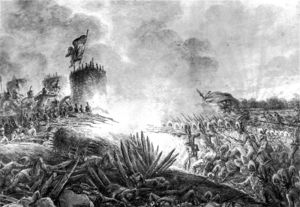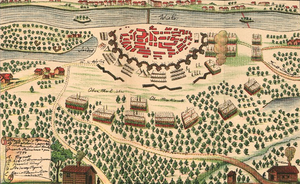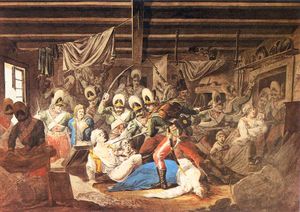- Battle of Praga
-
Battle of Praga Part of the Kościuszko Uprising
Obrona Pragi (Defence of Praga) by Aleksander OrłowskiDate November 4, 1794 Location Praga, Warsaw Result Decisive Russian victory Belligerents Polish rebels
 Russian Empire
Russian EmpireCommanders and leaders Józef Zajączek Aleksandr Suvorov Strength 14,000 regulars, 3,200 militia
Less than 90 cannons17,000 men (assaulting)
104 cannonsCasualties and losses 6,000 killed or wounded
10,000 taken prisoner[1]580 killed, 960 injured[2] 7,000[1] to 10,000-15,000[3] to up to 20,000[4] civilians killed - Racławice
- Warsaw
- Wilno
- Greater Poland
- Szczekociny
- Chełm
- Siege of Warsaw
- Krupczyce
- Terespol
- Maciejowice
- Praga
The Battle of Praga or Battle of Warsaw of 1794 was a Russian assault of Praga, the easternmost suburb of Warsaw, during the Kościuszko Uprising in 1794. It was followed by a massacre (known as the Massacre of Praga[a] ) of the civilian population of Praga.
Contents
Eve of the battle
After the Battle of Maciejowice General Tadeusz Kościuszko was captured by the Russians. The internal struggle for power in Warsaw and the demoralisation of the city's population prevented General Józef Zajączek from finishing the fortifications surrounding the city both from the east and from the west. At the same time the Russians were making their way towards the city.
Opposing forces
The Russian forces consisted of two battle-hardened corps under Generals Aleksandr Suvorov and Ivan Fersen. Suvorov took part in the recent Russo-Turkish war, then in the heavy fighting in Polesie and finally in the Battle of Maciejowice. Fersen fought for several months in Poland, but was also joined by fresh reinforcements sent from Russia. Each of them had approximately 11,000 men.
The Polish forces consisted of a variety of troops. Apart from the rallied remnants of the Kościuszko's army defeated in the Battle of Maciejowice, it also included a large number of untrained militia from Warsaw, Praga and Vilnius, a 500-man Jewish regiment of Berek Joselewicz as well as a number of scythemen and civilians.[5] The forces were organised in three separate lines, each covering a different part of Praga. The central area was commanded directly by General Józef Zajączek, the northern area was commanded by Jakub Jasiński and the southern by Władysław Jabłonowski. Altogether, the Polish commander had less than 20,000 men.
Battle
The Russian forces reached the outskirts of Warsaw on November 3, 1794. Immediately upon arrival, the Russian forces started artillery barrage of the Polish defences. This made the Polish commander think that the opposing forces were preparing for a long siege. However, Suvorov's plan assumed the fast and concentrated assault on the Polish defences rather than a bloody and lengthy siege.
At 3 o'clock in the morning of November 4 the Russian troops silently reached the positions just outside the outer rim of Polish field fortifications and two hours later started an all-out assault. The Polish defenders were completely surprised and soon the Polish lines were broken onto several isolated pockets of resistance, bombarded by the Russians with canister shots with a devastating effect. General Zajączek was slightly wounded and retreated from his post, leaving the remainder of his forces without command. This made the Poles retreat towards the centre of Praga and then towards Vistula.
The heavy fighting lasted for four hours and resulted in a complete defeat of the Polish forces. Joselewicz survived, being severely wounded, but almost all of his command was annihilated; Jasiński was killed fighting bravely on the front line. Only a small part managed to evade encirclement and retreated to the other side of the river across a bridge; hundreds of soldiers and civilians fell from a bridge and drowned in the process.
Massacre
After the battle ended, the Russian troops, against the orders given by Suvorov before the battle, started to loot and burn the entire borough of Warsaw (allegedly in revenge for the slaughter or capture of over half the Russian Garrison in Warsaw[6] during the Warsaw Uprising in April 1794, when about 2,000 Russian soldiers died[7]). Almost all of the area was pillaged and inhabitants of the Praga district were tortured, raped and murdered[citation needed]. The exact death toll of that day remains unknown, but it is estimated that up to 20,000 people were killed.[4] Suvorov himself wrote: "The whole of Praga was strewn with dead bodies, blood was flowing in streams."[8]It was thought that unruly Cossack troops were partly to blame for the uncontrolled destruction.[9]. Suvorov tried to stop the massacre by ordering the destruction of the bridge to Warsaw over the Vistula river [10] with the purpose of preventing the spread of violence to Warsaw. Other historians dispute this.[11]
After the battle
After the battle the commanders of Warsaw and large part of its inhabitants became demoralised. To spare Warsaw the fate of its eastern suburb, General Tomasz Wawrzecki decided to withdraw his remaining forces southwards and on November 5. Warsaw was captured by the Russians with little or no opposition. It is said that after the battle General Aleksandr Suvorov sent a report to Catherine the Great consisting of only three words: hurrah - Praga - Suvorov. The empress of Russia replied equally briefly: Bravo Fieldmarshal, Catherine,[12] promoting him to Field Marshal for this victory.[7] The massacre of Praga dented Suvorov and the Russian army's reputation throughout Europe.[13]
See also
- List of massacres in Poland
References and notes
a ^ The Polish term for the massacre, rzeź Pragi, correctly translates as Slaughter of Praga. Most English sources however use the term massacre, not slaughter, for the event.
- ^ a b (Polish) Dorosnąć do wielkości
- ^ (Russian) Бантыш-Каменский Д. Биографии российских генералиссимусов и генерал-фельдмаршалов. — СПб.: В тип. 3-го деп. Мингосимуществ,1840; [1]
- ^ The Kosciuszko Uprising 2 - The Siege of Warsaw and Defeat (1794)
- ^ a b "According to one Russian estimate 20,000 people had been killed in the space of a few hours" (Adam Zamoyski: The Last King of Poland, London, 1992 p.429)
- ^ Tgnacy Schipper, Zydzi Krolestwa Polskiego w dobie Powstuia Listopadowego, Warszawa, 1932.
- ^ Madariaga: Catherine the Great: a Short History (Yale) p.175
- ^ a b John T. Alexander, Catherine the Great: Life and Legend, Oxford University Press US, 1999, ISBN 0195061624, Google Print, p.317
- ^ Isabel de Madariaga, Russia in the Age of Catherine the Great, Sterling Publishing Company, Inc., 2002, ISBN 1-84212-511-7, Google Print, p.446
- ^ John Leslie Howard, Soldiers of the Tsar: Army and Society in Russia, 1462-1874, Keep, Oxford University Press, 1995, ISBN 019822575X, Google Print, p.216
- ^ (Russian)A. F. Petrushevsky. "Generalissimo Prince Suvorov", chapter "Polish war: Praga, 1794", originally published 1884, reprinted 2005, ISBN 5-98447-010-1
- ^ (Polish) Janusz Tazbir, Polacy na Kremlu i inne historyje (Poles on Kreml and other stories), Iskry, 2005, ISBN 83-207-1795-7, fragment online
- ^ Norman Davies, Europe: A History, Oxford University Press, 1996, ISBN 0-19-820171-0, Google Print, p.722
- ^ Madariaga: Catherine the Great p.175
External links
Categories:- Battles of the Kościuszko Uprising
- History of Warsaw
- Massacres in Poland
Wikimedia Foundation. 2010.




